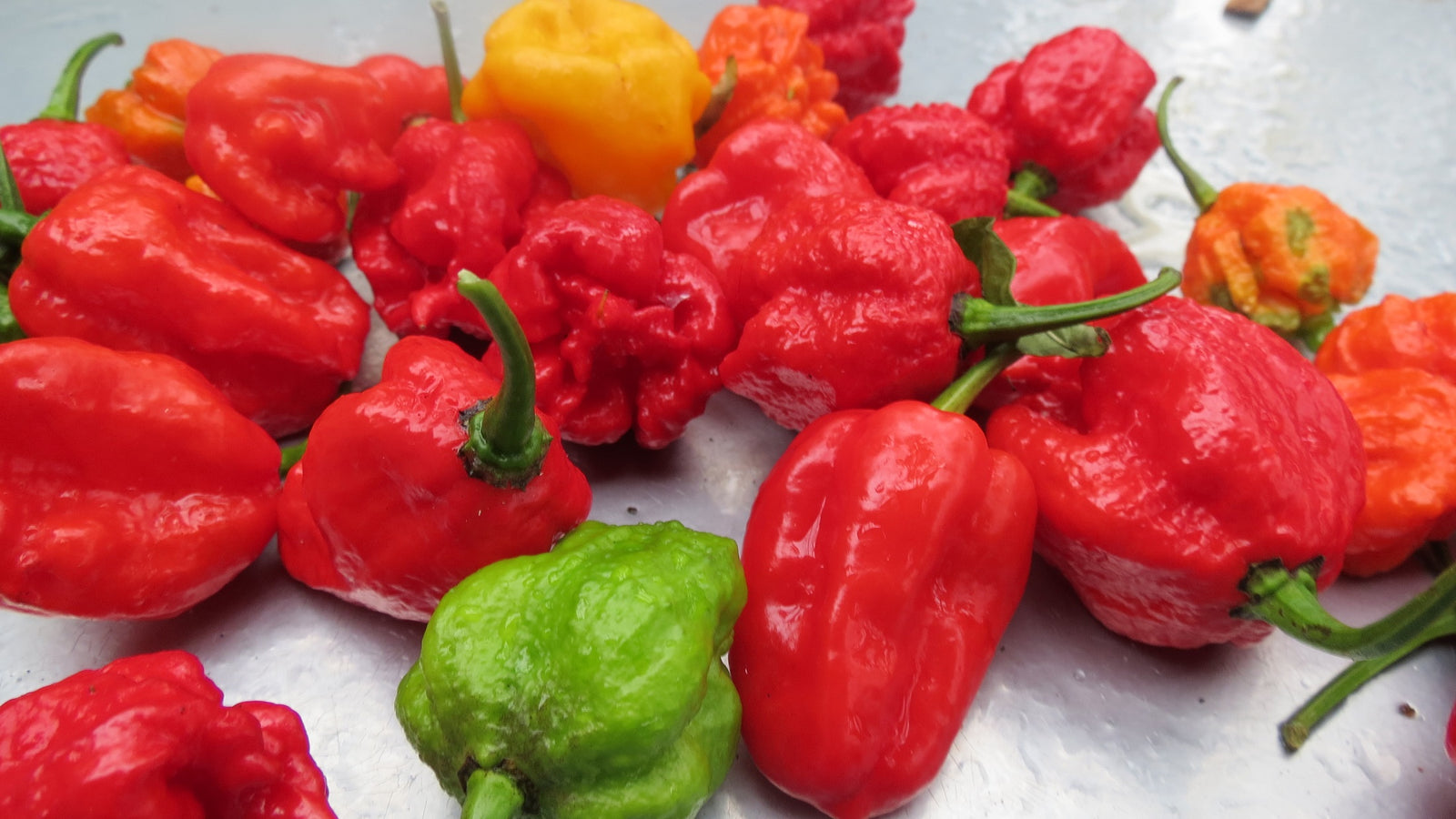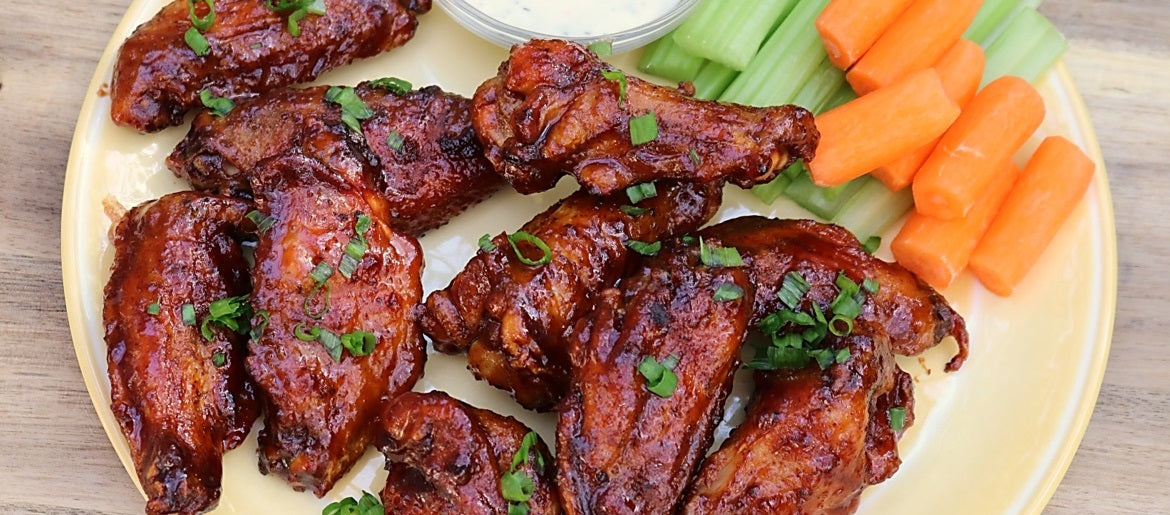Types of Hot Peppers
Characteristics of the more commonly sought-out peppers such as the Carolina Reaper, Trinidad Scorpion, Naga Jolokia (Ghost Pepper), Habanero, Fatalii, Datil, Jalapeno and Chipotle.
Carolina Reaper Pepper
According to Guinness World Book of Record’s, Smokin Ed’s ‘Carolina Reaper’, developed and grown by Ed Currie from the PuckerButt Pepper Company is now the hottest pepper in the world. The Carolina Reaper can reach 2,200,000 Scoville Heat Units (SHU).
Trinidad Moruga Scorpion Pepper

The Trinidad Moruga Scorpion Pepper has a tender fruit-like flavor, which makes it a sweet-hot combination.
Naga Jolokia “Ghost” Pepper

Using standard the pepper heat scale rating, the Ghost Pepper has been rated 1,041,427 Scoville units, which is twice as hot as its closest competitor, the Red Savina Habanero.
Although grown in several Northeastern parts of India, it is primarily grown in the Assam state. It has been reported that the fruit is whipped on fence posts to act as a barrier to elephants in India. The fruits are about 2.5” to 3” in length when ripe and a red color. A single ounce of the dried pepper can sell between $8 and $10.
On April 9th of 2009 a 28 year old Indian woman, Anandita Dutta Tamuly, ate 51 Naga Jolokia peppers in two minutes. The accomplishment will earn her a spot in Guinness World Records.
Habanero Pepper

Although some believe the Habanero originated in Cuba, the majority opinion is that the Habanero originated in the Yucatán Peninsula and its coastal regions, where it is still very popular today.
The Habanero has a fruity, citrus-like flavor with an intense heat. It has become very popular and is used in many different food dishes, salsas, hot sauces and even to infuse a hot spicy flavor into Tequila.
Fatalii Pepper

Fatalii plants grow on average to about 2', but can grow as tall as 4'. Fatalii Peppers are green when young and turn yellow as they mature with fruits around 3" long. Fatalii's thrive in full sun and do well in pots.
Behind the Fatalii's intense fire, there is a citrus flavor with a taste of lemon and sometimes peach.
Datil Pepper

St. Augustine, Florida is known for its Datil Peppers and Datil Hot Sauces. In fact, more Datil Peppers are grown in the St. Augustine area than any other place in the world.
The Minorcans moved to St. Augustine in the late 1700’s and brought their Datil Pepper seeds. Datils have been grown there for over 250 years and are a staple in the Minorcan community. For more about Minorcan history and a recipe for Datil Pepper Seafood Chowder visit our Datil Pepper Squidoo page.
Jalapeno Pepper

Jalapeno pepper lovers enjoy the warm, burning sensation when eaten. The heat intensity for these peppers ranges from 3,000 to 6,000 Scoville Units. Most of the substance that causes the hot sensation (capsaicin) is concentrated in the veins of the peppers and the seeds (which are next to the veins. As a result, when using Jalapenos in a recipe, you can make the heat a little milder by removing the veins and seeds from the peppers (as a suggestion, you should wear latex gloves and not touch your eyes or areas). In fact, Jalapenos have been known to cause skin irritation in some people.
The Jalapeno has been around for thousands of year. It gets its name after Jalapa, Veracruz where the pepper was traditionally grown (however, is not longer grown there). Mexico and the U.S. are the largest producers of Jalapenos. Mexico has over 39,500 acres dedicated to Jalapeno cultivation and the U.S has over 5,500 acres. Texas and New Mexico are the lead producing states in the U.S. In fac, Texas has a special affiliation with the Jalapeno. It has been their official state pepper since 1995.
Mature Jalapeno plants are approximately three feet tall (or a little less). Each plant will produce 25 – 30 peppers. Throughout the growing season, green jalapenos will be picked from a plant several times. As the growing season comes to an end, the jalapeños start to turn red. The red peppers are typically used to make Chipotles (see below).
Jalapeno peppers have found countless uses in North American cuisine. They are canned, sliced, pickled and added to many products such as Nachos, Jelly, Potato Chips, Salsa, Hot Sauce, Vodka, Cornbread, Jalapeno Ketchup, Jalapeno Coleslaw, Jalapeno Cheetos, Jalapeno Pistachios, Chutney, Guacamole, Stews, Soups and many more foods.
In recent years, Jalapeno Jelly has grown in popularity. Though debatable, Lake Jackson, Texas claims that Jalapeno Jelly originated in their town and marketed starting in 1978.
Perhaps, a more popular Jalapeno appetizer is the Jalapeno Popper. These are common in many restaurants and consist of jalapeno peppers stuffed with cheese, usually cheddar or cream cheese, which are then breaded and deep fried. Wisconsin claims to be the originator of these delicious items, but this claim is “hotly” contested.
No article on the Jalapeno would be complete on this website if we didn’t mention Armadillo Eggs. We can't claim any credit for the infamous Armadillo Egg, but for those that are interested, Armadillo Eggs are Jalapenos stuffed with cheese & bacon, then rolled in Bisquick and baked. Armadillo Eggs became popular during the 1990’s and are an excellent appetizer. (Armadillos are mammals, so no real eggs.) Just do an Internet search using your favorite search engine and you will find plenty of Armadillo Egg recipes to use for your next cookout or party.
Chipotle Pepper
 Chipotle Peppers are simply dried and smoked Jalapeno Peppers with a sweet and spicy, smoke flavor. They lose a little of the Jalapeno heat through the smoking process, but are still considered a medium heat pepper.. Chipotle Peppers range in size from 2 to 5 inches long and approximately an inch wide.
Chipotle Peppers are simply dried and smoked Jalapeno Peppers with a sweet and spicy, smoke flavor. They lose a little of the Jalapeno heat through the smoking process, but are still considered a medium heat pepper.. Chipotle Peppers range in size from 2 to 5 inches long and approximately an inch wide. Chipotle Peppers originated in the area around Mexico City prior to the Aztecs. Today, the Northern Mexican state of Chihuahua is the leading producer of Chipotles. Anyone who has ever grown Jalapenos understands that they easily rot. It is believed that the Aztecs made Chipotles for preservation purposes. As much as 1/5 of Mexico’s Jalapeno crop is used for Chipotles. Their popularity continues to grow and you can know find dishes in the U.S. from coast to coast to use Chipotle Peppers.
According to Wikipedia, after several passes through the Jalapeno fields (toward the end of the growing season) of picking the highest quality Jalapenos, the remaining Peppers turn a deep red color and are then used to make Chipotles. There are many methods for smoking the peppers including traditional smoking, gas dryers and the use of liquid smoke. Most Chipotle lovers still agree that wood (pecan, hickory, oak) smoked Chipotles are superior in quality and flavor. Chipotle Peppers are packaged as dried peppers, powdered, canned, bottled as Hot sauce and as marinade.
How Do you Put Out the Pepper Fire?
What is the best way to put out that fire after eating a pepper that’s a little too hot? Scientists report that capsaicin breaks down in fats. So, some milk, sour cream or a little ice cream might help. Foods with increased fat have more capability of squelching the fire. Some believe that starch helps put out the flame. The popular cure in Mexico is to consume beer.






